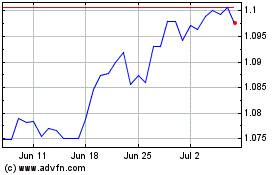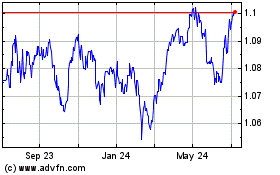Australian, Canadian Dollars Fall Amid Risk Aversion
October 26 2016 - 10:15PM
RTTF2
The Australian and the Canadian dollars weakened against their
major currencies in the Asian session on Thursday as the
risk-averse investors digested disappointing corporate earnings
results and the continued decline in crude oil prices. Crude oil
prices slipped on Wednesday after the American Petroleum Institute
or API reported that U.S. crude stocks rose by 4.8 million
barrels.
Concerns over whether OPEC would reduce its production at its
November meeting also weighed on the oil price demand. Russia and
OPEC are dragging their feet over a planned reduction in output
that would have helped to stabilize oil prices.
Interfax reports Russia is now against OPEC production cuts,
while Iraq and others say they should be exempt.
In other economic news, the Australian Bureau of Statistics
showed that export prices in Australia advanced 3.5 percent on
quarter in the third quarter of 2016. That beat forecasts for an
increase of 2.0 percent following the 1.4 percent gain in the
previous three months.
Import prices were down 1.0 percent on quarter versus
expectations for a 0.8 percent decline. They were unchanged from
the second quarter.
Data from the National Bureau of Statistics showed that China's
industrial profits grew only 7.7 percent year-on-year in September
after expanding 19.5 percent in August. The increase in August was
the fastest in three years.
Wednesday, the Australian dollar rose 0.70 percent against the
U.S. dollar, 0.37 percent against the yen, and 0.76 percent against
the euro. The Canadian dollar fell 0.10 percent against the U.S.
dollar, 0.02 percent against the yen, and 0.55 percent against the
euro
In the Asian trading, the Australian dollar fell to 2-day lows
of 0.7622 against the U.S. dollar and 1.4304 against the euro, from
yesterday's closing quotes of 0.7649 and 1.4256, respectively. If
the aussie extends its downtrend, it is likely to find support
around 0.75 against the greenback and 1.47 against the euro.
Against the yen, the Canadian, and the New Zealand dollars, the
aussie dropped to 79.56, 1.0206 and 1.0655 from yesterday's closing
quotes of 79.92, 1.0234 and 1.0690, respectively. The aussie may
test support near 77.00 against the yen, 0.99 against the loonie
and 1.05 against the kiwi.
The Canadian dollar fell to a 3-day low of 1.3395 against the
U.S. dollar, from yesterday's closing value of 1.3379. The loonie
may test support near the 1.35 region.
Against the yen and the euro, the loonie dropped to 77.89 and
1.4603 from yesterday's closing quotes of 78.08 and 1.4594,
respectively. If the loonie extends its downtrend, it is likely to
find support around 76.00 against the yen, and 1.48 against the
euro.
Meanwhile, the safe-haven yen recovered from early losses
against its major rivals on risk aversion.
The yen rose to 113.70 against the euro and 74.65 against the NZ
dollar, from early lows of 114.17 and 74.85, respectively. If the
yen extends its uptrend, it is likely to find resistance around
112.00 against the euro and 73.00 against the kiwi.
Against the pound, the U.S. dollar and the Swiss franc, the yen
advanced to 127.42, 104.30 and 104.93 from an early 9-day low of
128.14, a 2-day low of 104.69 103.00 and a 1-week low of 105.35,
respectively. The yen may test resistance around 125.00 against the
pound, 103.00 against the greenback and 103.00 against the
franc.
Looking ahead, Swiss UBS consumption indicator data for
September is due for release in the pre-European session at 2:00 am
ET.
Eurozone M3 money supply data for September and U.K. third
quarter GDP data are slated for release later in the day.
At 6.00 am ET, the Confederation of British Industry is
scheduled to release Distributive Trades survey results.
In the New York session, U.S. durable goods orders for
September, U.S. weekly jobless claims for the week ended October
22, and U.S. pending home sales data for September are set to be
published. At 1:00 am ET, European Central Bank board member Yves
Mersch is expected to speak at the Hachenburg Conference organised
by Hochschule der Deutschen Bundesbank in Hachenburg, Germany.
Later in the day, a number of EU commissioners and finance
ministers are scheduled to meet to discuss Brexit, migration and
economic growth at Globsec Tatra Summit in Bratislava.
AUD vs NZD (FX:AUDNZD)
Forex Chart
From Mar 2024 to Apr 2024

AUD vs NZD (FX:AUDNZD)
Forex Chart
From Apr 2023 to Apr 2024
